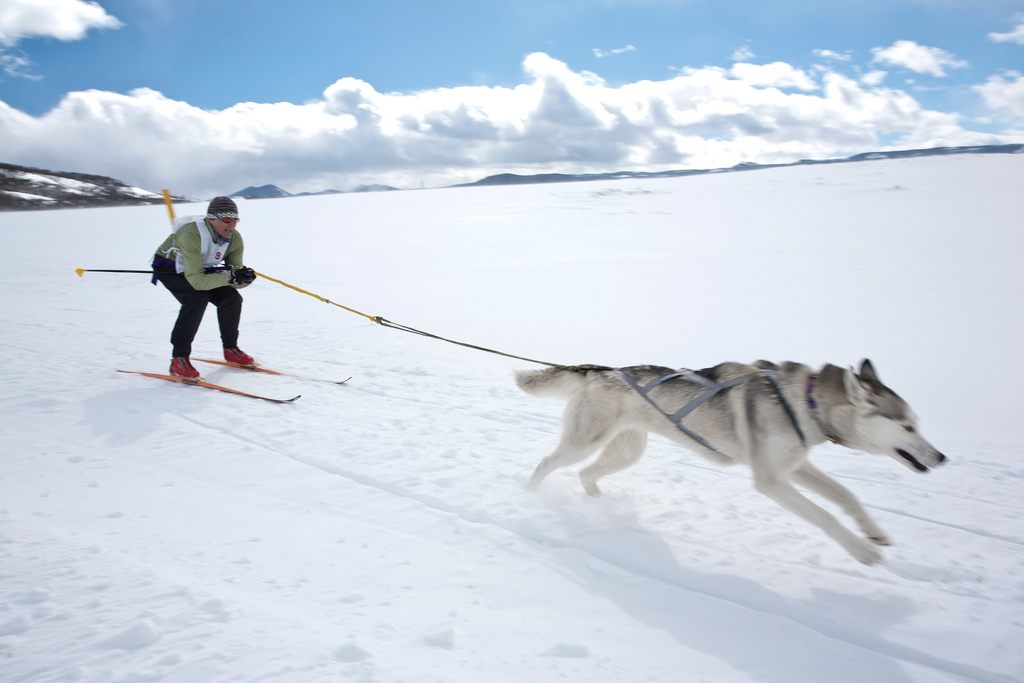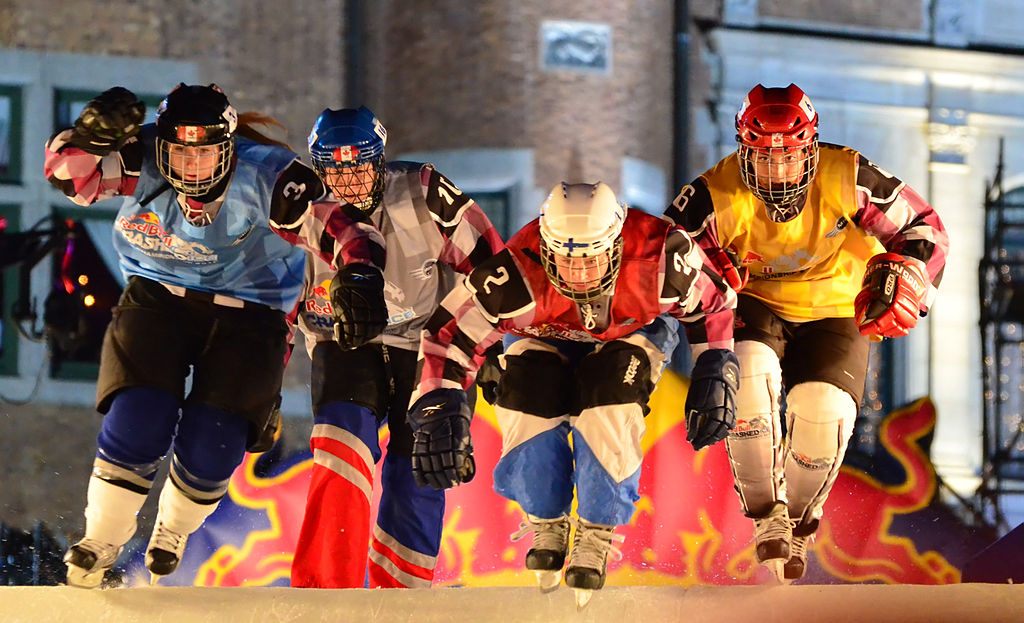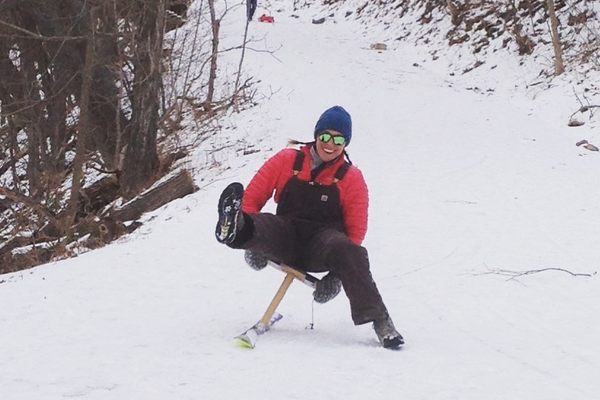5 Truly Odd Sports Invented in the Depths of Winter

Equestrian skijoring: a real inter-species team sport. (Photo: Kaila Angello/WikiCommons CC BY-SA 3.0)
Winter’s first big snowfall means getting ready to plow through some powder—on a shovel, behind a horse, or in a kayak.
Skis and snowboards get all the press, but they are just the tip of the proverbial iceberg of winter sports. Over the past few decades, pockets of outdoor enthusiasts scattered across our globe’s colder climes have experimented with new ways to make use of the magical thing that is snow—whether it be through power of horses or creek boats, these wild and wacky winter sports will soon have you scooting down the driveway with your buttocks tucked into a snow shovel.
Snow Kayaking
A short while back, experienced kayakers had the idea of taking their creek boats up mountaintops and cruising down soft, powdery waves of snow. Snow kayaking, also called snow boating, has officially been around since 2002, when a local group of Austrian kayakers held the sport’s first race. Since then, hundreds of eager folks have participated in snow kayaking world championships. While recreational snow kayakers like to paddle through the backcountry (which generally requires carrying boats uphill), competitive races, which are also known as boatercross, take place on a fixed course and involve four kayakers racing against one another. With a good helmsman, a snow kayak can surf the high snows—add a parachute, and you can also paddle through the skies.

Does this remind anyone of the movie Balto? (Photo: PhotoBobil/flickr)
Skijoring
Think water skiing, but on snow, and with a horse, dogs, or motor vehicle pulling you forward at brisk speeds across crazy obstacle courses or romantic fields of white. “Skijoring” (or ski joring) comes from a Norwegian word meaning “ski driving.” One imagines that in the depths of Scandinavian winters it would serve as a fairly efficient form of transport.
The sport, which has been around for hundreds of years, is practiced both recreationally and competitively. Dog skijoring is the most common and involves a skier attached to up to three dogs by a belt and towline. Any athletic type of dog can be harnessed up, from the classic huskies and malamutes to pointers, setters, golden retrievers, and labs. Dog skijoring races are usually between five and 20 kilometers long, though there’s one in Russia stretching 270 miles, and another in Yukon that’s 120.
In 1928, equestrian skijoring was introduced as a demonstration sport in the 1928 Winter Olympics. Though it was never picked up by the Olympic Committee, ambitious folks continued combining horsepower plus skis. There’s now a World Skijoring Championship in Whitefish, Montana that’s been taking place since 2009, as well as a smattering of other events. These competitions involve a skier being towed along by a horse whose rider guides it through the course while the skier completes a series of jumps and other obstacles, such as grabbing hanging rings.
Horse and rider, skier and obstacles—it’s quite the feat of coordination.

A German skijoring adventure back in 1963. Had to make winter exciting somehow! (Photo: Bundesarchiv/WikiCommons CC-BY-SA 3.0)
If strapping yourself up to dogs or horses isn’t enough, you can hitch yourself to a snowmobile or ATV and sail across the snow that way. But maybe try it first with Fido—you could end up zooming across your backyard.
Shovel Racing
Shovel racing, unlike snow kayaking, came into the world with far less intentionality. A number of decades ago, a worker at a ski resort was tasked with refilling bare patches along the slope. He found that riding his grain shovel from patch to patch was far faster than walking with it, and so shovel racing was born.

This kid looks like he might belong in the “Little Scoop” age category. (Photo: Lynn Eubank/WikiCommons CC BY-SA 2.0)
The birthplace? Angel Fire Ski Resort in New Mexico, which has hosted shovel racing competitions since the 1970s. The sport, which has been described as “a poor man’s luge of sorts,” involves tucking your rump in a standard, unmodified steel shovel with the handle between your legs, straightening your body, leaning back as close to the ground as possible, and then speeding downhill. Seasoned competitors, with the help of a little shovel waxing, can reach speeds up 73 miles per hour (a world record set by John “Shovelmeister” Strader).
From 2005 to 2010, Angel Fire suspended their Shovel Racing World Championship due to safety concerns over a new type of modified shovel. This modified shovel, which resembled a race car on skis, was showcased for one year in the 1997 Winter X Games before being removed (again, safety concerns).
Shovel racing seems to be a family sport. At the Angel Fire Championships, there’s a category called “Little Scoops” for six to nine year olds as well as the youth and adult groups. Even the Little Scoops reach speeds of up to 40 miles per hour on the race course. That kind of speed isn’t for the faint of heart, but some backyard trial runs could really liven up your winter shoveling routine.
Ski Ballet
Ski ballet, if you’ve never heard of it, has been widely hailed as one of the more extraordinary and extraordinarily bizarre sports, or forms of dance, to exist. It’s elegant, it’s creative, it’s physically impressive—ski ballet really has it all. Somehow, however, ski ballet has faded into history while other freestyle disciplines like aerials and moguls have gained prominence.
Ski ballet, also known as “acroski,” involved a ballet skier performing 90-second acrobatic routines set to music. Judges would evaluate the quality of the performance, both physically—the flips, jumps, and rolls—and artistically, not unlike figure skating. In fact, some ballet skiers even incorporated axels, normally a figure skating jump.
Ski ballet was a demonstration sport at both the 1998 and 1992 Winter Olympics, but it failed to make the cut. Yet from the late 1960s to 2000, there were all sorts of competitive ski ballet events—enough for Jan Bucher, one of ski ballet’s greats, to win 59 World Cup accolades over the course of a decade. The sport also included pair ballet, which incorporated lifts (wearing skis)! Ski ballet is without question one of the most loved weird sports of winters past.
 A group of ladies takes to the track, competing for downhill ice cross champ. (Photo: Letartean/WikiCommons CC BY 3.0)
A group of ladies takes to the track, competing for downhill ice cross champ. (Photo: Letartean/WikiCommons CC BY 3.0)
Downhill Ice Cross
If ski ballet is for dancers, then downhill ice cross is for frat bros. The competing demographic is almost entirely white, male, and 18 to 34 years old (though there are some women out there competing too).
Downhill ice cross features four skaters outfitted in full hockey padding racing down a walled ice track that features sharp turns and steep drops. World championships for the sport, sponsored by Red Bull, were held starting in 2010, and now there are “Crashed Ice” events in multiple cities in Europe and North America each winter. These events draw thousands of spectators and are continuing to gain speed. Former ice hockey hopefuls are reveling in the sport’s newfound glory, and some are hoping it will join ski cross and snowboard cross in the Winter Olympics.

Why put away your boat for the winter when you could swap water for snow? (Photo: Alex Kerney/WikiCommons CC BY 2.0)
But anyway, these are just five winter activities to get you started. Next time it snows, take out a pair of skis or skates, a dog, horse, parachute or odd item from your garage, and who knows? Maybe you’ll accidentally come up with the next great winter sport.










Follow us on Twitter to get the latest on the world's hidden wonders.
Like us on Facebook to get the latest on the world's hidden wonders.
Follow us on Twitter Like us on Facebook